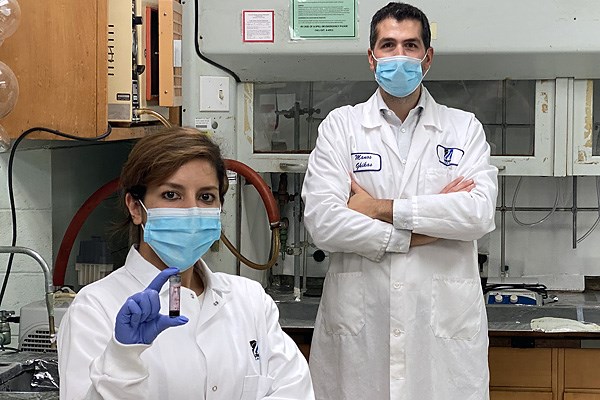Mass Life Sciences Center Funds UMass Lowell-Led Work

UMass Lowell Chemistry Assistant Prof. Manos Gkikas, right, is shown with Ph.D. student Shayesteh Tafazoli, who is holding a vial of gold-based nanoparticle contrast agent for use in X-ray spectral CT.
02/17/2021
Contacts for media: Nancy Cicco, 978-934-4944, Nancy_Cicco@uml.edu and Christine Gillette, 978-758-4664, Christine_Gillette@uml.edu
LOWELL, Mass. – A research team led by UMass Lowell is pioneering a new 3D imaging technique to better detect breast cancer and other diseases, including COVID-19.
The noninvasive medical technology uses specialized contrasting dye that recognizes breast cancer cells, allowing practitioners to better visualize human tissue inside the body. The dye amplifies the X-ray signal in tumors when used together with a state-of-the-art computed tomography (CT) scanner, called a “photon-counting spectral CT,” which produces multi-colored, 3D images.
“The contrast agents, combined with spectral CT and machine learning, could lead to a more precise diagnosis of the disease and assist significantly in early intervention,” said UMass Lowell Chemistry Assistant Prof. Manos Gkikas, who is leading the project, which is funded by a three-year, $750,000 grant from the Massachusetts Life Sciences Center.
Other team members include UMass Lowell’s Hengyong Yu, professor of electrical and computer engineering, and Mary Rusckowski, associate professor of radiology at UMass Medical School in Worcester. MARS Bioimaging Ltd., a leader in photon-counting spectral CT technology, is providing $210,000 in additional funding to support the research as an industry partner.
UMass Lowell doctoral students Shayesteh Tafazoli, Dayang Wang and Yongshun Xu, all of Lowell, are contributing to the work under the direction of Gkikas and Yu.
“To the best of our knowledge, this is the first time this type of combined research is being done. It highlights the importance of X-ray CT in medicine, a field where UMass is strong,” said Gkikas, who lives in Boston.
Breast cancer is the most common type and the second-leading cause of cancer deaths in American women, according to the American Cancer Society. The organization estimates about 281,550 new cases of invasive breast cancer will be diagnosed in U.S. women this year. Many cases are discovered when the disease is at an advanced stage, making earlier detection and diagnosis key to improving patients’ outlook and chances of survival.
“Detecting early signatures of this terrible disease will significantly improve the rate of survival of patients. Prof. Manos Gkikas and his collaborators are pursuing novel ideas that have the potential to yield new technologies that could save many lives. I am pleased to see work being conducted by researchers from different colleges at UMass Lowell and from our sister campus UMass Medical School,” said Noureddine Melikechi, dean of UMass Lowell’s Kennedy College of Sciences.
The research team believes the combined use of the specialized dye and the colored 3D X-ray images generated by spectral CT will revolutionize medical imaging, according to Gkikas.
“This can assist radiologists in discriminating between healthy and cancerous tissues. They can use those images to determine if a cyst or a tumor requires further examination or biopsy,” Yu said. “The resulting data can then be amplified even further using image reconstruction algorithms and machine learning, enabling us to track a tumor’s progression in primary breast cancer.”
Unlike conventional contrasting agents, the specialized dye being developed by the research team can specifically target cancer cells and remain in the body for an extended time, which would improve the accuracy of diagnoses, according to Gkikas.
“In our approach, we are designing contrast agents that could stay in the body for a prolonged period. They can accumulate at the cancer site and enhance the CT signal to better visualize the tumor,” he said.
The imaging would also allow practitioners to track a tumor’s progression in primary breast cancer. In addition, the researchers hope to expand the technology to one day detect secondary, metastatic cancers that have spread beyond their primary site to other tissues or organs in the body. Such metastatic cancers can sometimes emerge anywhere from four to 10 years after treatment of the original cancer, according to Gkikas.
“In combining the expertise of our researchers across disciplines and institutions, we have established a unified front working to defeat breast cancer. The researchers are also aiming to use this method to detect COVID-19 and other diseases. We look forward to developing the many ways this cutting-edge technology could help save lives,” said James Sherwood, dean of UMass Lowell’s Francis College of Engineering.
In a separate project funded by UMass Lowell, Gkikas is applying the imaging technique to detect COVID-19 and track the progress of lung inflammation in patients coping with the disease.
UMass Lowell is a national research university offering its more than 18,000 students bachelor’s, master’s and doctoral degrees in business, education, engineering, fine arts, health, humanities, sciences and social sciences. UMass Lowell delivers high-quality educational programs and personal attention from leading faculty and staff, all of which prepare graduates to be leaders in their communities and around the globe. www.uml.edu
